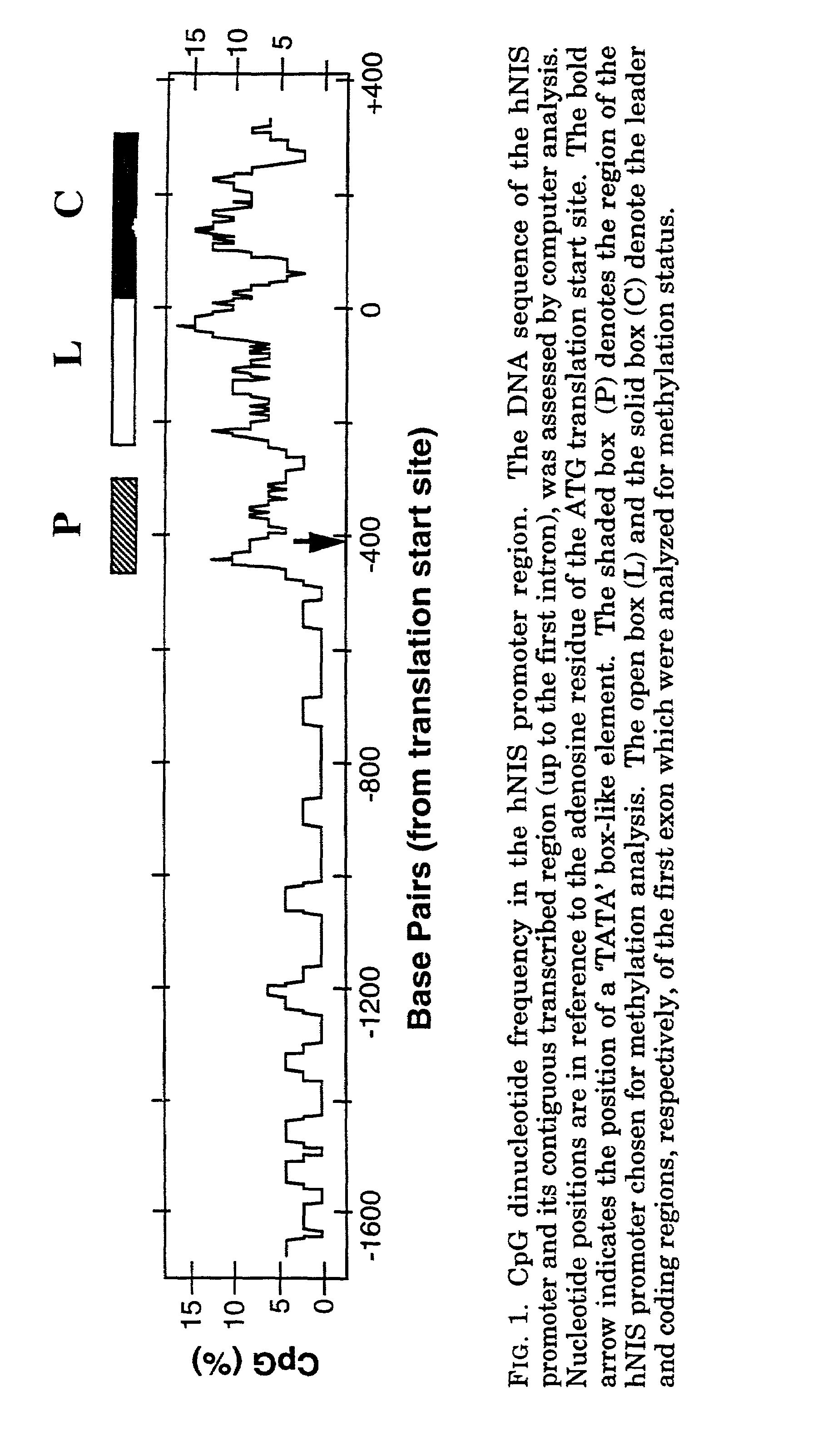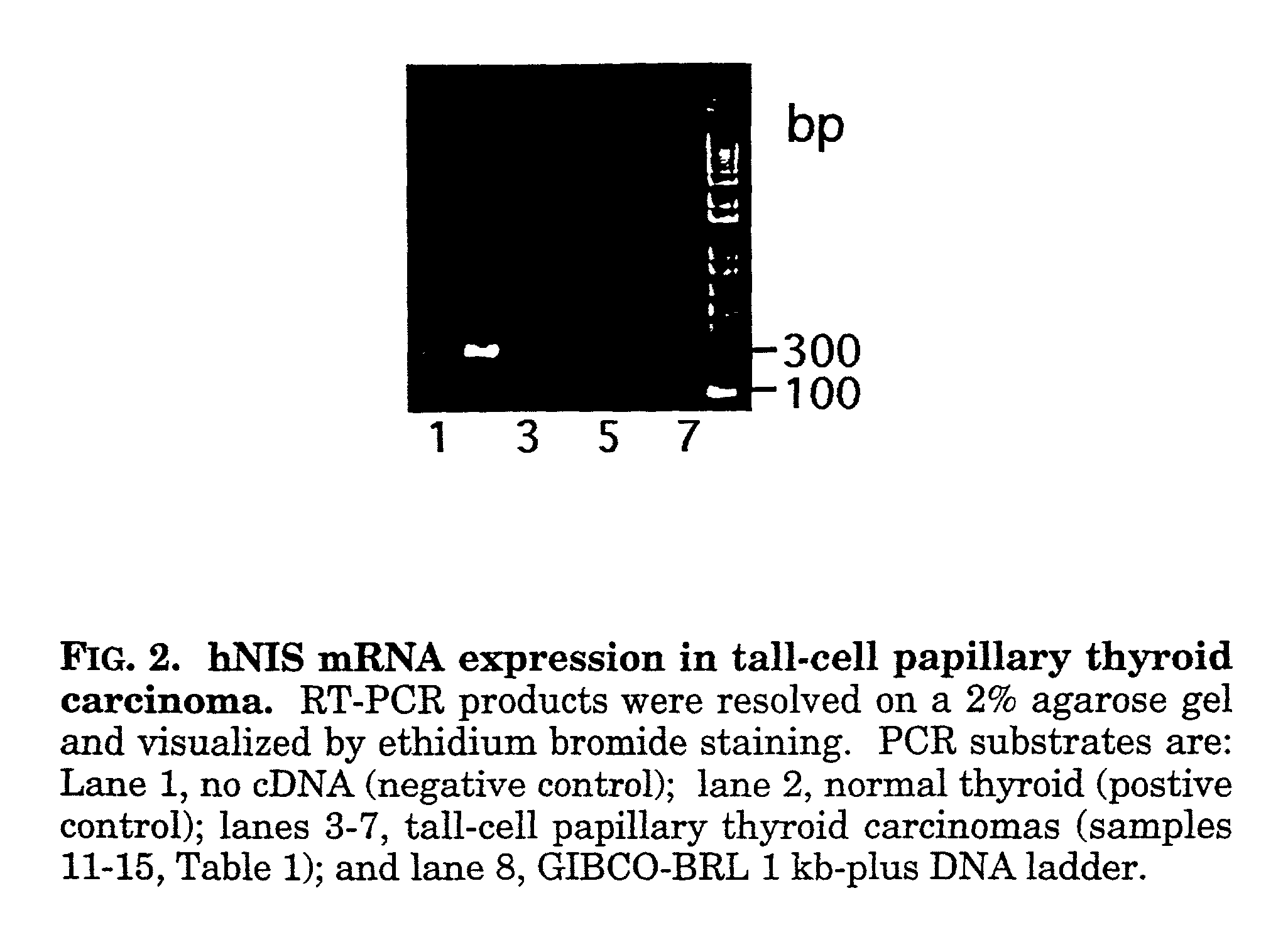Iodine uptake restoration in thyroid cancer
a thyroid cancer and iodine uptake technology, applied in the field of iodine uptake restoration in thyroid cancer, can solve the problems of loss of gene expression, inability to take up radioactive iodide, inability to respond to systemic chemotherapies, and significant morbidity and mortality of around 10% of patients with differentiated thyroid cancer, etc., to inhibit methylation, inhibit dna-methyltransferase activity, and inhibit methylation
- Summary
- Abstract
- Description
- Claims
- Application Information
AI Technical Summary
Benefits of technology
Problems solved by technology
Method used
Image
Examples
example 1
Materials and Methods
Cell Lines and Human Tissues
[0038]Human thyroid cell lines used were: MRO87 and WRO82 (both follicular carcinomas), NPA'87 (papillary carcinoma), KAT-5 and KAT-10 (both papillary carcinomas (16)), KAK-1 (benign follicular adenoma (17)), and KAT-7 (benign follicular hyperplasia). Cultures were previously treated with medium containing D-valine (18) and cis-4-hydroxy-L-proline (19) to ensure the absence of fibroblasts. Human thyroid tissues were obtained from fresh surgical samples (approved by University of Kentucky Institutional Review Board). Some tumor samples were supplied by the Cooperative Human Tissue Network (Philadelphia, Pa.) and some were obtained from surgical samples at the Clinical Center, National Institutes of Health, Bethesda, Md. (under approved protocol).
Cell Culture
[0039]Cell lines, for evaluation of iodide-uptake and hNIS expression, were grown in phenol-red-free RPMI 1640 with 5% fetal bovine serum (FBS), 100 nM sodium selenite and 0.1 nM bo...
example 2
Results
CpG Dinucleotide Distribution in the Context of the hNIS Promoter
[0047]The hNIS promoter region, and its contiguous downstream regions up to the first intron, were analyzed for the presence of CpG islands. The frequency plot (FIG. 1) shows a region of the promoter, surrounding the transcription start site (5) and extending upstream for about 100 base pairs, to be rich in CpG dinucleotides (region P). This was the only upstream region in the characterized promoter that was CpG-rich. Sequence comparison revealed that this region shared significant homology to the rat NIS promoter region (26). This region was selected for analysis of methylation status in clinical tumors and cell lines. Additional CpG-rich sequences are present downstream from this region, extending to the first intron. Regions L and C, selected for methylation analysis, corresponded to CpG-rich sequences in the hNIS leader and coding regions, respectively, within the first exon.
hNIS mRNA expression and Clinical...
example 3
Inhibition of Polyamine Synthesis Restores Sodium / Iodide Symporter Gene Expression and Activity in Dedifferentiated Thyroid Carcinoma Cell Lines
[0055]hNIS transcriptional failure in thyroid carcinoma could be consequent to methylation of DNA in critical regulatory regions and could be reversed by inhibition of DNA-methyltransferase. Restoration of hNIS gene expression and activity from direct DNA-methyltransferase inhibition by 5-azacytidine has been shown. Reports suggest that decarboxylated S-adenosylmethionine (dcSAM) is an endogenous inhibitor of DNA methylation, competing against the methyl-donor, S-adenosylmethionine. Since dcSAM is consumed by synthesis of polyamines (putrescine, spermidine, spermine) and its synthetic enzyme (adenosylmethionine decarboxylase) is stimulated by polyamine depletion, blockade of polyamine synthesis precipitously increases dcSAM levels. This should block DNA-methyltransferase activity and restore lost hNIS expression in dedifferentiated thyroid c...
PUM
| Property | Measurement | Unit |
|---|---|---|
| Therapeutic | aaaaa | aaaaa |
| Transport properties | aaaaa | aaaaa |
Abstract
Description
Claims
Application Information
 Login to View More
Login to View More - R&D
- Intellectual Property
- Life Sciences
- Materials
- Tech Scout
- Unparalleled Data Quality
- Higher Quality Content
- 60% Fewer Hallucinations
Browse by: Latest US Patents, China's latest patents, Technical Efficacy Thesaurus, Application Domain, Technology Topic, Popular Technical Reports.
© 2025 PatSnap. All rights reserved.Legal|Privacy policy|Modern Slavery Act Transparency Statement|Sitemap|About US| Contact US: help@patsnap.com



